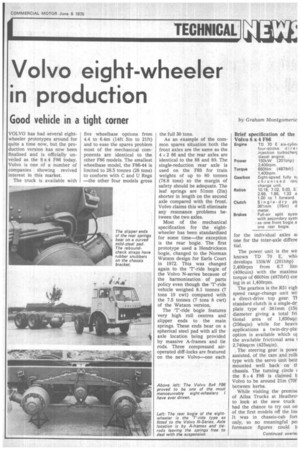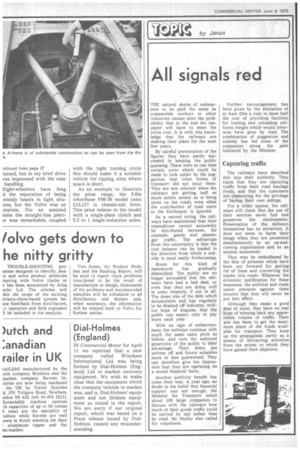Volvo eight-wheeler in production
Page 29

Page 30

If you've noticed an error in this article please click here to report it so we can fix it.
Good vehicle in a tight corner
VOLVO has had several eightwheeler prototypes around for quite a time now, but the production version has now been finalised and is officially unveiled as the 8 x 4 F86 today. Volvo is one of a number of companies showing revived interest in this market.
The truck is available with five wheelbase options from 4.4 to 6.4m (14ft 5in to 21ft) and to ease the spares problem most of the mechanical components are identical to the other F86 models. The smallest wheelbase model, the F86-44 is limited to 28.5 tonnes (28 tons) to conform with C and U Regs —the other four models gross the full 30 tons.
As an example of the common spares situation both the front axles are the same as the 4 x 2 86 and the rear axles are identical to the 88 and 89. The single-reduction rear axle is used on the F89 for train weights of up to 80 tonnes (78.8 tons) so the margin of safety should be adequate. The leaf springs are 51mm (2in) shorter in length on the second axle compared with the front. Volvo claims this will eliminate any resonance problems between the two axles.
Most of the mechanical specification for the eightwheeler has been standardised for some time—the exception is the rear bogie. The first prototype used a Hendrickson bogie, changed to the Norman Watson design for Earls Court in 1972. This was changed again to the 'T'-ride bogie of the Volvo N-series because of the harmonisation of parts policy even though the 'T'-ride vehicle weighed 8.1 tonnes (7 tons 19 cwt) compared with the 7.5 tonnes (7 tons 8 cwt) of the Watson version.
The 'T'-ride bogie features very high roll centres and slipper ends to the main springs. These ends bear on a spherical steel pad with all the axle location being provided by massive A-frames and tie rods. Three compressed airoperated duff-locks are featured on the new Volvo—one each for the individual axles al one for the inter-axle differe tial.
The power unit is the we known TD 70 E, whii develops 150kW (201bhp) 2,400rpm from 6.7 litri (409cuin) with the maximu torque of 660Nm (4871bft) cor ing in at 1,400rpm. The gearbox is the R51 eigh speed range-change unit wii a direct-drive top gear. TI standard clutch is a single-dr: plate type of 381mm (150 diameter giving a total fri. tional area of 1,650sqc (256sqin) while for heavil applications a twin-dry-plal option is available which ui the available frictional area I 2,740sqcm (425sqin).
. The steering gear is powe assisted, of the cam and roll( type with the servo unit bein mounted well back on tt chassis. The turning circle ( the 8 > 4 F86 is claimed b Volvo to be around 21m (70f. between kerbs.
While visiting the premise of Ailsa Trucks at Heathro, to look at the new truck had the chance to try out on of the first models off the lin( It was in chassis-cab fort only, so no meaningful pei formance figures could b tamed, but in my brief drive vas impressed with the ease handling.
Eight-wheelers have long d the reputation of being wieldy beasts in tight situLons, but the Volvo was an ception. For an assisted stem the straight-line precini was remarkable; coupled with the tight turning circle this should make it a suitable vehicle for tipping sites where space is short.
As an example to illustrate the price range, the 5.6m wheelbase F86-56 model costs £15,127 in chassis-cab form. This price relates to the model with a single-plate clutch and 5.3 to 1 single-reduction axles,


















































































































